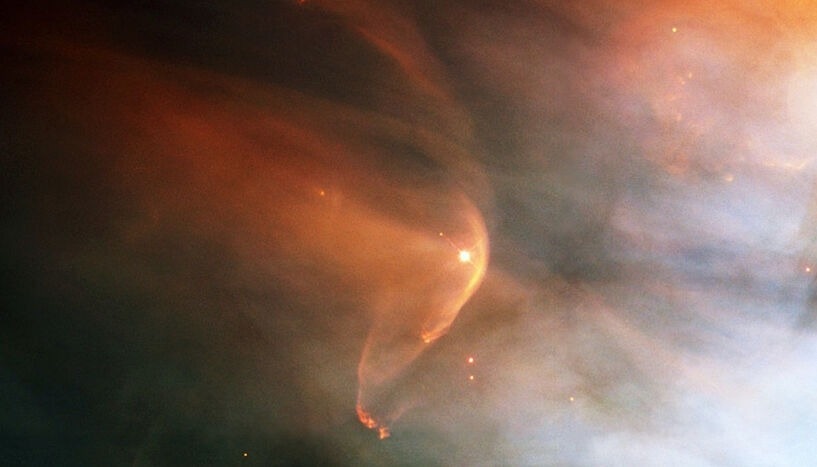Reviewed by Lexie CornerApr 15 2024
By observing the X-Ray emission from the astrospheres of three Sun-like stars, an international research team led by a University of Vienna researcher has successfully detected the stellar winds from these stars for the first time, and they have also placed limits on the mass loss rate of the stars through their stellar winds. Nature Astronomy published the study.
 Infrared image of the shockwave (red arc) created by the massive giant star Zeta Ophiuchi in an interstellar dust cloud. The tenuous winds of sun-like main-sequence stars are much more difficult to observe C: NASA/JPL-Caltech; NASA and The Hubble Heritage Team (STScI/AURA). Image Credit: O’Dell, Vanderbilt University
Infrared image of the shockwave (red arc) created by the massive giant star Zeta Ophiuchi in an interstellar dust cloud. The tenuous winds of sun-like main-sequence stars are much more difficult to observe C: NASA/JPL-Caltech; NASA and The Hubble Heritage Team (STScI/AURA). Image Credit: O’Dell, Vanderbilt University
Astrospheres, stellar equivalents of the solar system’s heliosphere, are very hot plasma bubbles blown by stellar winds into the interstellar medium, a gas and dust-filled vacuum.
The study of the stellar winds of low-mass stars like the Sun helps us to better comprehend stellar and planetary development, as well as the past and future of the star and solar system. Stellar winds drive several processes that evaporate planetary atmospheres into space, resulting in atmospheric mass loss.
Although planets’ escape rates over an hour or even a year are extremely low, they function over lengthy geological periods. The losses accumulate and can be the deciding factor in whether a planet evolves into a livable environment or an airless rock. Despite their importance for the evolution of both stars and planets, winds from Sun-like stars are infamously difficult to control.
They are mostly made up of protons and electrons, with a small amount of heavier, highly charged ions (for example, oxygen and carbon). These ions produce X-Rays by collecting electrons from the neutrals in the interstellar medium surrounding the star.
X-Ray Emission from Astropheres Detected
An international research team led by Kristina Kislyakova, Senior Scientist at the University of Vienna’s Department of Astrophysics, has detected for the first time X-Ray emission from the astrospheres of three sun-like stars, known as main sequence stars, which are stars in their prime of life, and has thus recorded such winds for the first time directly, enabling them to place constraints on the stars' mass loss rate via their stellar winds.
These findings, based on observations with the XMM-Newton space telescope, are being published in Nature Astronomy. The researchers used XMM-Newton to detect the spectral fingerprints (also known as spectral lines) of oxygen ions, allowing them to quantify the amount of oxygen and, eventually, the total mass of stellar wind released by the stars.
The researchers assessed the mass loss rates of three stars with identified astrospheres: 70 Ophiuchi, epsilon Eridani, and 61 Cygni, to be 66.5±11.1, 15.6±4.4, and 9.6±4.1 times the solar mass loss rate, respectively. This suggests that the winds from these stars are substantially greater than the solar wind, which might be attributed to their higher magnetic activity.
In the solar system, solar wind charge exchange emission has been observed from planets, comets, and the heliosphere and provides a natural laboratory to study the solar wind’s composition. Observing this emission from distant stars is much more tricky due to the faintness of the signal. In addition to that, the distance to the stars makes it very difficult to disentangle the signal emitted by the astrosphere from the actual X-Ray emission of the star itself, part of which is "spread" over the field-of-view of the telescope due to instrumental effects.
Kristina Kislyakova, Senior Scientist, University of Vienna
“We have developed a new algorithm to disentangle the stellar and the astrospheric contributions to the emission and detected charge exchange signals originating from stellar wind oxygen ions and the surrounding neutral interstellar medium of three main-sequence stars. This has been the first time X-Ray charge exchange emission from astrospheres of such stars has been detected. Our estimated mass-loss rates can be used as a benchmark for stellar wind models and expand our limited observational evidence for the winds of Sun-like stars,” Kislyakova added.
Study co-author Manuel Güdel, also of the University of Vienna, added, “There have been world-wide efforts over three decades to substantiate the presence of winds around Sun-like stars and measure their strengths, but so far only indirect evidence based on their secondary effects on the star or its environment alluded to the existence of such winds; our group previously tried to detect radio emission from the winds but could only place upper limits to the wind strengths while not detecting the winds themselves. Our new X-Ray-based results pave the way to finding and even imaging these winds directly and studying their interactions with surrounding planets.”
“In the future, this method of direct detection of stellar winds in X-Rays will be facilitated thanks to future high resolution instruments, like the X-IFU spectrometer of the European Athena mission. The high spectral resolution of X-IFU will resolve the finer structure and emission ratio of the oxygen lines (as well as other fainter lines), that are hard to distinguish with XMM's CCD resolution, and provide additional constraints on the emission mechanism; thermal emission from the stars, or non-thermal charge exchange from the astrospheres,” further added CNRS researcher Dimitra Koutroumpa, a co-author of the study.
Journal Reference:
Kislyakova, K., et al. (2024) X-Ray detection of astrospheres around three main-sequence stars and their mass-loss rates. Nature Astronomy. doi:10.1038/s41550-024-02222-x